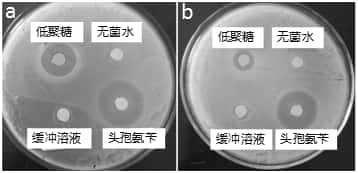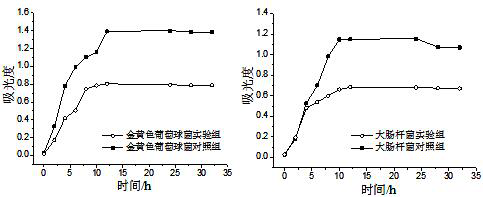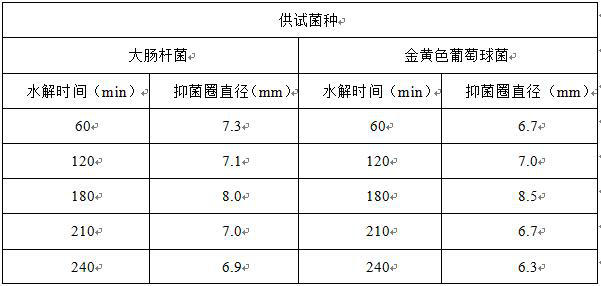Method for preparing melon rind pectin oligosaccharide with bacteriostatic activity by utilizing immobilized enzyme
A technology of pectin oligosaccharides and antibacterial activity, applied in the field of preparation of pectin oligosaccharides, can solve the problems of few types, low output, high cost, etc., and achieve high antibacterial activity, good repeatability, and low cost Effect
- Summary
- Abstract
- Description
- Claims
- Application Information
AI Technical Summary
Problems solved by technology
Method used
Image
Examples
Embodiment 1
[0027] Optimum pH value determination example
[0028] Raw material pretreatment
[0029] Choose non-mildew melon rind waste such as watermelon, seed melon, melon, cantaloupe, remove the pulp, wash, chop, inactivate enzymes in boiling water for 5 minutes, drain the water, dry, and crush to obtain melon rind powder.
[0030] Preparation of pectin oligosaccharides from melon rind by immobilizing enzymes on activated carbon
[0031] Take 5 parts of melon rind powder, add 100 mL of buffer solutions with pHs of 3.0, 3.5, 4.0, 4.5, and 5.0 to prepare and 1.0 g of activated carbon to immobilize pectinase, and react in a water bath at 45 °C for 180 min to obtain pectin oligomerization sugar, and the antibacterial activity of the pectin oligosaccharides prepared under the corresponding conditions were determined respectively.
[0032] As shown in Table 1, the melon rind pectin oligosaccharide prepared at pH 4.0 has the best inhibitory effect on both Staphylococcus aureus and Escheric...
Embodiment 2
[0036] Best hydrolysis time determination embodiment
[0037] Raw material pretreatment
[0038] Choose non-mildew melon rind waste such as watermelon, seed melon, melon, cantaloupe, remove the pulp, wash, chop, inactivate enzymes in boiling water for 5 minutes, drain the water, dry, and crush to obtain melon rind powder.
[0039] Take 5 parts of melon rind powder, add 100 mL of buffer solution with pH 4.0 and 1.0 g of activated carbon-immobilized pectinase, and react in a water bath for 60 min, 120 min, 180 min, 210 min, and 240 min at 45 °C to obtain fruit. Pectin oligosaccharides were tested for antibacterial activity of pectin oligosaccharides prepared under corresponding conditions.
[0040] As shown in Table 2, the melon rind pectin oligosaccharides prepared when the enzymatic hydrolysis time was 180 min had the best inhibitory effect on Staphylococcus aureus and Escherichia coli.
[0041] Table 2 The effect of different hydrolysis time on the preparation conditions of...
Embodiment 3
[0044] Optimum enzymolysis temperature determination example
[0045] Raw material pretreatment
[0046] Choose non-mildew melon rind waste such as watermelon, seed melon, melon, cantaloupe, remove the pulp, wash, chop, inactivate enzymes in boiling water for 5 minutes, drain the water, dry, and crush to obtain melon rind powder.
[0047] Take 5 parts of melon rind powder, add 100 mL of buffer solution with pH 4.0 and 1.0 g of activated carbon-immobilized pectinase, and react in water bath for 180 min at 30°C, 35°C, 40°C, 45°C, and 50°C to obtain For pectin oligosaccharides, the antibacterial activity of pectin oligosaccharides prepared under corresponding conditions was determined respectively.
[0048] As shown in Table 3, the melon rind pectin oligosaccharides prepared when the enzymatic hydrolysis temperature was 45°C had the best inhibitory effect on Staphylococcus aureus and Escherichia coli.
[0049] Table 3 Effects of different temperatures on the preparation conditi...
PUM
 Login to View More
Login to View More Abstract
Description
Claims
Application Information
 Login to View More
Login to View More - R&D Engineer
- R&D Manager
- IP Professional
- Industry Leading Data Capabilities
- Powerful AI technology
- Patent DNA Extraction
Browse by: Latest US Patents, China's latest patents, Technical Efficacy Thesaurus, Application Domain, Technology Topic, Popular Technical Reports.
© 2024 PatSnap. All rights reserved.Legal|Privacy policy|Modern Slavery Act Transparency Statement|Sitemap|About US| Contact US: help@patsnap.com










